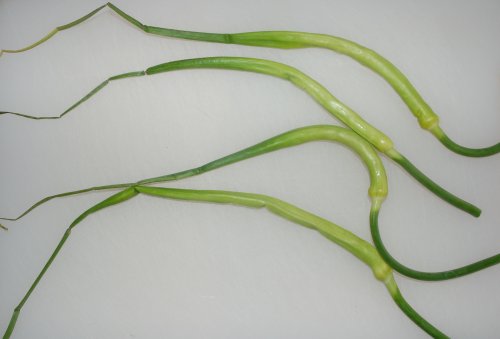
I was at the garden on Friday and harvested about 2 Kg of garlic scapes! Because I’m so far north, I always end up harvesting my scapes weeks after everyone else has posted about them. By now scapes are old news to most of you!
After giving away scapes to everyone we could think of, we made pesto out of the rest.
No formal recipe for the pesto, just pureed the scapes in the food processor with enough olive oil to make it liquefy well, then stirred in grated Parmesan cheese. I was amazed at how much olive oil it took to make a good consistency, it’s like the pesto scapes just absorb the oil as you add it. In the end, I added something in excess of a half a liter of oil. When eating it, we found it needed a further drizzle of oil, and we roasted some pine nuts to put on top, as well as a bit of salt.
I’ve never made garlic scape pesto before, and it was nice. The raw taste gets to be a bit much after awhile, and wow — that garlicky aftertaste in your mouth is something else! Honestly I prefer scapes in a stirfry, but this was a nice change too. The problem with scapes is always how to keep them. They are only good for a week or so after harvest and don’t freeze or dehydrate well, even if they are blanched first. I’ve read that as pesto it stores better in the freezer. I hope so, because we’ve probably got enough pesto to last years!
So far my garlic plants look really good! Both John and Rebsie have reported garlic rust in the UK, but I haven’t seen any on my plants yet. It’s late enough in the season that if my plants do get infected, it probably won’t impact the harvest much.
One of the more exciting garlics for me this year is called Gazebo Grande. I received it from a member of the Seed Savers Exchange who lives in Wisconsin, in the USA. She developed it in her own garden, and I am one of the first people she has shared it with. True to the name, the plants are huge! I’m looking forward to seeing it after harvest.
Last year I sent planting samples of my garlic out to several people, and I had enough for everyone who wanted some. I expect to do the same this year, so watch out for announcements the end of August or so. I can’t send it to the US, because US customs doesn’t allow it. I can send it most other places. I don’t know yet what the costs will be, but you should expect to at least pay for shipping. I also always accept trades! If you have something to offer in exchange, please let me know.




